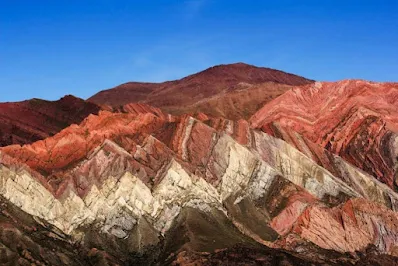Argentina's Rainbow Valley: Quebrada de Humahuaca
The Quebrada de Humahuaca is a valley in the Jujuy province of Argentina. It is known for its colorful mountains, which are thought to have been formed over millions of years. The colors of the mountains are due to the presence of different minerals, including iron oxide, manganese oxide, and copper oxide.
The incredible colors and the inverted-V shaped formation seen here is part of the limestone formation called Yacoraite that extends from Peru to Salta, through Bolivia and the Quebrada de Humahuaca.The Hill of Seven Colors and Painter's Palette in Maimará are famous, but most visitors leave the creek without knowing the mountains of Hornocal or “Serranias del Hornocal”.
 |
| Argentina's Rainbow Valley: Quebrada de Humahuaca Hornocal Hill | © Klaus Balzano / Shutterstock |
The Serranía de Hornocal are a range of mountains located 25 kilometers from the city of Humahuaca in the Argentine province of Jujuy. Exposed in the range is the limestone formation called Yacoraite that extends from Salta, Argentina, through the Argentine Quebrada de Humahuaca and then through the Bolivian Altiplano to Peru, The Yacoraite Formation is a largely Mesozoic geologic formation.
Serranía del Hornocal is a best example of the Flatirons, this landform is small knolls with a triangular to trapezoidal-shaped sloping surface with the long side of this surface as their base and a point at their top. It was created by the differential erosion of a steeply dipping, erosion-resistant layer of rock overlying softer strata. Flatirons have wide bases that form the base of a steep, triangular facet that narrows upward into a point at its summit. The dissection of a hogback by regularly spaced streams often resulted in the formation.
 |
| Argentina's Rainbow Valley: Quebrada de Humahuaca Photo: © Bookmundi.com |
 |
| Quebrada-de-Humahuaca. Photo by Ossian Lindholm |
See also:
The Rainbow Mountains in Peru Very Amazing
'Mountain of God' the Weirdest Volcano in the World


%20(1).webp)





